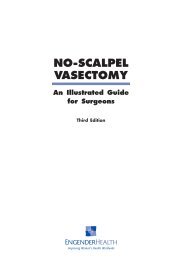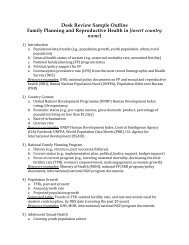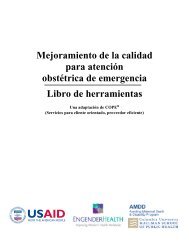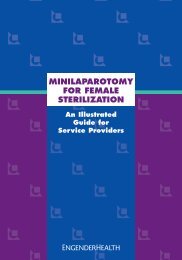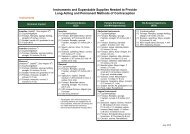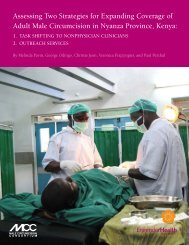COPE® FOR MALE CIRCUMCISION SERVICES - EngenderHealth
COPE® FOR MALE CIRCUMCISION SERVICES - EngenderHealth
COPE® FOR MALE CIRCUMCISION SERVICES - EngenderHealth
You also want an ePaper? Increase the reach of your titles
YUMPU automatically turns print PDFs into web optimized ePapers that Google loves.
COPE for Male Circumcision Services<br />
4. Do health talks or individual counseling sessions cover the following topics<br />
■ HIV transmission<br />
■ HIV prevention<br />
■ What MC is and what the procedure involves, including potential risks and benefits<br />
(including, ideally, photographs to show men what a circumcised penis looks like)<br />
■ That MC reduces risk of HIV transmission by up to 60%<br />
■ That MC alone does not completely protect a client from contracting HIV, including<br />
information about other HIV prevention strategies that can be used<br />
■ The availability of confidential HIV testing for MC clients and the importance of being<br />
tested at the time of MC<br />
■ Signs and symptoms of sexually transmitted infections (STIs) in both men and women<br />
and STIs’ role in promoting the spread of HIV<br />
■ Information about referrals for HIV care, treatment, and support services (if available)<br />
■ Where applicable, how to reduce the risk of HIV transmission among injecting drug<br />
users (IDUs)<br />
■ That MC does not prevent HIV transmission resulting from injections or skin punctures<br />
■ How to use male condoms correctly, through age-appropriate demonstrations for men,<br />
that use a penis or vagina model and that ask the client to repeat the condom demonstration<br />
to confirm his understanding<br />
■ Information about how to reduce condom error and avoid condom failure or breakage<br />
5. Do the staff at your MC setting routinely inform clients on the availability of HCT, MC,<br />
and other HIV- and AIDS-related services<br />
6. Do staff always explain to men the following types of examinations or procedures that will<br />
be done in relation to MC, what to expect, and why the examinations or procedures are<br />
needed<br />
■ Reproductive health education<br />
■ HCT<br />
■ Informed consent for surgery<br />
■ Medical history<br />
■ Physical examination to assess for contraindications to MC (e.g., anatomical<br />
abnormality, genital ulcer disease, urethral discharge, etc.)<br />
■ Surgical procedure, including preparation for the surgery, anesthesia, and description of<br />
method used (e.g., dorsal slit, forceps guided, or sleeve resection method)<br />
■ Postoperative and intraoperative care and management of complications, including<br />
wound care and follow-up visits<br />
■ Referral to other specialized services based on the needs of the client (e.g., care and<br />
treatment for HIV-positive men, STI treatment, etc.)<br />
7. Are educational aids on MC, HIV, HCT, and related topics, such as pamphlets, posters,<br />
anatomical models, and condom samples, available<br />
18 <strong>EngenderHealth</strong>



